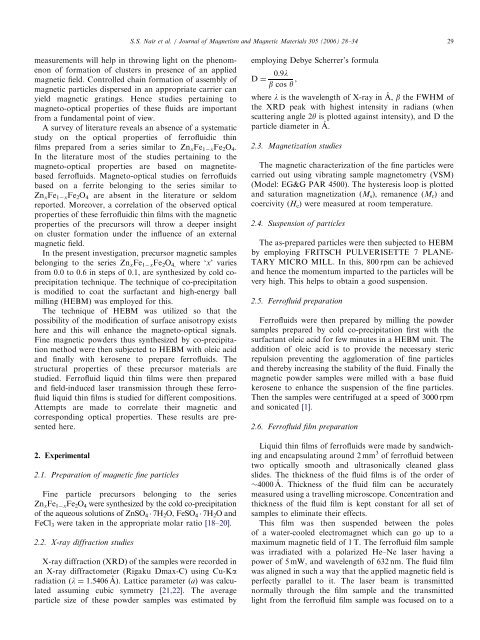Magnetic field-induced cluster formation and variation of magneto ...
Magnetic field-induced cluster formation and variation of magneto ...
Magnetic field-induced cluster formation and variation of magneto ...
Create successful ePaper yourself
Turn your PDF publications into a flip-book with our unique Google optimized e-Paper software.
measurements will help in throwing light on the phenomenon<br />
<strong>of</strong> <strong>formation</strong> <strong>of</strong> <strong>cluster</strong>s in presence <strong>of</strong> an applied<br />
magnetic <strong>field</strong>. Controlled chain <strong>formation</strong> <strong>of</strong> assembly <strong>of</strong><br />
magnetic particles dispersed in an appropriate carrier can<br />
yield magnetic gratings. Hence studies pertaining to<br />
<strong>magneto</strong>-optical properties <strong>of</strong> these fluids are important<br />
from a fundamental point <strong>of</strong> view.<br />
A survey <strong>of</strong> literature reveals an absence <strong>of</strong> a systematic<br />
study on the optical properties <strong>of</strong> ferr<strong>of</strong>luidic thin<br />
films prepared from a series similar to ZnxFe1 xFe2O4.<br />
In the literature most <strong>of</strong> the studies pertaining to the<br />
<strong>magneto</strong>-optical properties are based on magnetitebased<br />
ferr<strong>of</strong>luids. Magneto-optical studies on ferr<strong>of</strong>luids<br />
based on a ferrite belonging to the series similar to<br />
ZnxFe1 xFe2O4 are absent in the literature or seldom<br />
reported. Moreover, a correlation <strong>of</strong> the observed optical<br />
properties <strong>of</strong> these ferr<strong>of</strong>luidic thin films with the magnetic<br />
properties <strong>of</strong> the precursors will throw a deeper insight<br />
on <strong>cluster</strong> <strong>formation</strong> under the influence <strong>of</strong> an external<br />
magnetic <strong>field</strong>.<br />
In the present investigation, precursor magnetic samples<br />
belonging to the series Zn xFe 1 xFe 2O 4, where ‘x’ varies<br />
from 0.0 to 0.6 in steps <strong>of</strong> 0.1, are synthesized by cold coprecipitation<br />
technique. The technique <strong>of</strong> co-precipitation<br />
is modified to coat the surfactant <strong>and</strong> high-energy ball<br />
milling (HEBM) was employed for this.<br />
The technique <strong>of</strong> HEBM was utilized so that the<br />
possibility <strong>of</strong> the modification <strong>of</strong> surface anisotropy exists<br />
here <strong>and</strong> this will enhance the <strong>magneto</strong>-optical signals.<br />
Fine magnetic powders thus synthesized by co-precipitation<br />
method were then subjected to HEBM with oleic acid<br />
<strong>and</strong> finally with kerosene to prepare ferr<strong>of</strong>luids. The<br />
structural properties <strong>of</strong> these precursor materials are<br />
studied. Ferr<strong>of</strong>luid liquid thin films were then prepared<br />
<strong>and</strong> <strong>field</strong>-<strong>induced</strong> laser transmission through these ferr<strong>of</strong>luid<br />
liquid thin films is studied for different compositions.<br />
Attempts are made to correlate their magnetic <strong>and</strong><br />
corresponding optical properties. These results are presented<br />
here.<br />
2. Experimental<br />
2.1. Preparation <strong>of</strong> magnetic fine particles<br />
Fine particle precursors belonging to the series<br />
ZnxFe1 xFe2O4 were synthesized by the cold co-precipitation<br />
<strong>of</strong> the aqueous solutions <strong>of</strong> ZnSO4 7H2O, FeSO4 7H2O<strong>and</strong><br />
FeCl3 were taken in the appropriate molar ratio [18–20].<br />
2.2. X-ray diffraction studies<br />
X-ray diffraction (XRD) <strong>of</strong> the samples were recorded in<br />
an X-ray diffractometer (Rigaku Dmax-C) using Cu-Ka<br />
radiation (l ¼ 1:5406 ˚ A). Lattice parameter (a) was calculated<br />
assuming cubic symmetry [21,22]. The average<br />
particle size <strong>of</strong> these powder samples was estimated by<br />
ARTICLE IN PRESS<br />
S.S. Nair et al. / Journal <strong>of</strong> Magnetism <strong>and</strong> <strong>Magnetic</strong> Materials 305 (2006) 28–34 29<br />
employing Debye Scherrer’s formula<br />
D ¼ 0:9l<br />
b cos y ,<br />
where l is the wavelength <strong>of</strong> X-ray in A˚ , b the FWHM <strong>of</strong><br />
the XRD peak with highest intensity in radians (when<br />
scattering angle 2y is plotted against intensity), <strong>and</strong> D the<br />
particle diameter in A˚ .<br />
2.3. Magnetization studies<br />
The magnetic characterization <strong>of</strong> the fine particles were<br />
carried out using vibrating sample <strong>magneto</strong>metry (VSM)<br />
(Model: EG&G PAR 4500). The hysteresis loop is plotted<br />
<strong>and</strong> saturation magnetization (M s), remanence (M r) <strong>and</strong><br />
coercivity (H c) were measured at room temperature.<br />
2.4. Suspension <strong>of</strong> particles<br />
The as-prepared particles were then subjected to HEBM<br />
by employing FRITSCH PULVERISETTE 7 PLANE-<br />
TARY MICRO MILL. In this, 800 rpm can be achieved<br />
<strong>and</strong> hence the momentum imparted to the particles will be<br />
very high. This helps to obtain a good suspension.<br />
2.5. Ferr<strong>of</strong>luid preparation<br />
Ferr<strong>of</strong>luids were then prepared by milling the powder<br />
samples prepared by cold co-precipitation first with the<br />
surfactant oleic acid for few minutes in a HEBM unit. The<br />
addition <strong>of</strong> oleic acid is to provide the necessary steric<br />
repulsion preventing the agglomeration <strong>of</strong> fine particles<br />
<strong>and</strong> thereby increasing the stability <strong>of</strong> the fluid. Finally the<br />
magnetic powder samples were milled with a base fluid<br />
kerosene to enhance the suspension <strong>of</strong> the fine particles.<br />
Then the samples were centrifuged at a speed <strong>of</strong> 3000 rpm<br />
<strong>and</strong> sonicated [1].<br />
2.6. Ferr<strong>of</strong>luid film preparation<br />
Liquid thin films <strong>of</strong> ferr<strong>of</strong>luids were made by s<strong>and</strong>wiching<br />
<strong>and</strong> encapsulating around 2 mm 3 <strong>of</strong> ferr<strong>of</strong>luid between<br />
two optically smooth <strong>and</strong> ultrasonically cleaned glass<br />
slides. The thickness <strong>of</strong> the fluid films is <strong>of</strong> the order <strong>of</strong><br />
4000 A ˚ . Thickness <strong>of</strong> the fluid film can be accurately<br />
measured using a travelling microscope. Concentration <strong>and</strong><br />
thickness <strong>of</strong> the fluid film is kept constant for all set <strong>of</strong><br />
samples to eliminate their effects.<br />
This film was then suspended between the poles<br />
<strong>of</strong> a water-cooled electromagnet which can go up to a<br />
maximum magnetic <strong>field</strong> <strong>of</strong> 1 T. The ferr<strong>of</strong>luid film sample<br />
was irradiated with a polarized He–Ne laser having a<br />
power <strong>of</strong> 5 mW, <strong>and</strong> wavelength <strong>of</strong> 632 nm. The fluid film<br />
was aligned in such a way that the applied magnetic <strong>field</strong> is<br />
perfectly parallel to it. The laser beam is transmitted<br />
normally through the film sample <strong>and</strong> the transmitted<br />
light from the ferr<strong>of</strong>luid film sample was focused on to a

















